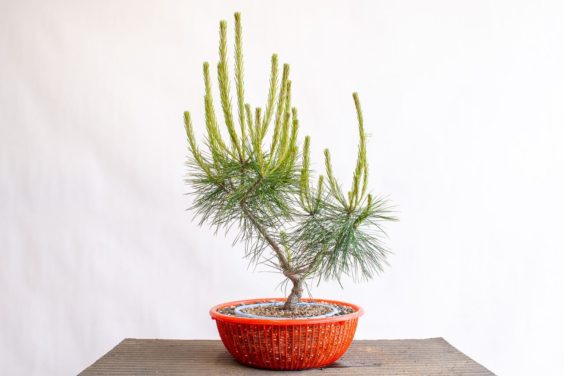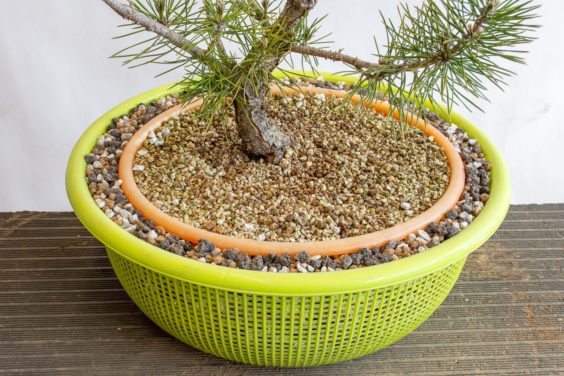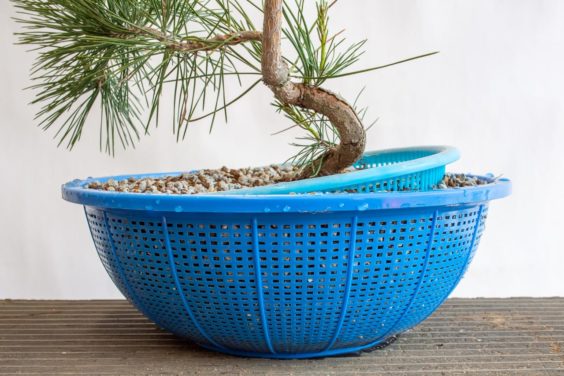For young trees growing in colanders, a repot isn’t always necessary when the roots run out of space. Here’s an overview of an alternative approach in two photos.
Red pine in 6″ colander
After nesting the colander within a larger colander
The theory behind this approach is that large roots are less likely to develop outside the inner colander. This focuses growth on the roots closest to the trunk – the roots that help the tree develop taper near the surface of the soil.
Like many techniques in bonsai, the double colander approach has its pros and cons. Apart from whether or not it improves the roots – I have yet to measure the effect – it’s worth considering as a fast and simple alternative to traditional repotting. And if a tree starts drying out too quickly in summer, it’s easy to nest it in a larger container without waiting until the next repotting season.
Sometimes I use the same size soil in both colanders and other times I use larger soil in the outer container. Am not sure it makes a big difference either way. The main thing is to let roots escape the inner container and begin growing in the outer one.
Nested colanders with larger soil in the outer container
The approach also facilitates subtle changes in the planting angle.
Inner colander set at an angle
As for the cons, the main one is that repotting can be a mess. Several years back, I mentioned my hesitation about the approach after finding the repotting process involved hacking through a jumble of roots and plastic scraps. I was happy with the roots in the inner container, but didn’t enjoy removing the plastic scraps from the used soil.
Subscribe to Bonsai Tonight
New Posts Delivered Every Tuesday and Friday




Brendan R says
If the theory is sound it may make for a good experiment to try this right from the outset? The test is whether a tree would have small roots escape rapidly beyond the inner colander to the outer ring, but thicken only in the inner ring. A sort of enforced ramification due to the physical barrier.
Jonas Dupuich says
Thanks, Brendan – good suggestion. I’m planning to try a number of trees in double colanders and then look closely when I repot a year or two from now and see if I can find any patterns. If it were easier to see the roots, I’d love to make before and after photos with and without the colanders. Will see how close I can come to this!
Kip says
Interesting outside the “colander” thoughts Jonas.
But now the real question that probably everyone asks, where do you get your colanders? The colors are awesome!
Jonas Dupuich says
Hi Kip, thanks for the note! Internet searches are the best place to start. There are a couple of tips here too: https://ask.bonsaitonight.com/t/where-can-i-find-those-pots/306/2
Clyde Grace says
99% of the time you put out good stuff. To put this out is to have absolutely no idea why colanders are used to begin with. Doubling them or putting them in the ground is 100% counter productive. The main point of using colanders is air pruning the roots. If you just want a big grow box use one.
Jonas Dupuich says
Hi Clyde, thanks for the note! I’d figured the air pruning proceeds exactly the same at the perimeter of the outer colander. The main difference is that some roots growing in the inside colander may be constrained by the narrow perforations – the hypothesis I’m curious to test.
As for putting colanders in or on the ground or in larger containers, I sometimes do this at the expense of the air pruning to provide the trees with more water so they don’t dry out as quickly.
Your comment is a good reminder that there is more to say on the topic – will see if I can be more clear in the future. Thanks!
Mike says
Hey Jonas, I’ve done side by side comparisons with colanders not allowed to escape, colanders that were set on the ground and allowed to escape through the bottom of the colander, and straight ground growing. After 4 years, there is a very noticeable difference in the growth in the colander pine allowed to escape into the ground….even out pacing the straight ground grown pines in the first four years. Even though you have to deal with cutting away larger roots from the outside of the pot (along with all those plastic bits) the inside of the colander still maintains a large, fine root system making transplant and recovery much easier than a regular field grown pine, which may lack a substantial amount of fine roots.
Jonas Dupuich says
Hi Mike – that’s awesome you’ve had such good results! I’m not at all surprised by the colander on the ground approach. It provides the fastest growth because the roots that grow into the ground accelerate overall growth. Keeping the colander above ground allows you to water more and maintain fine roots close to the trunk, thereby overcoming a primary fault of ground-only growing.
I’ve achieved a similar effect by placing a colander on top of a large plastic container and letting the tree get 6-7′ tall. The trunk thickened faster than any of my other trees and I still have good roots near the base of the trunk.
If you’re interested, feel free to share pics of these trees at https://ask.bonsaitonight.com
Thanks again!
Frank Corrigan says
My experience has been the same as Mike’s, superior growth with colandar placed in ground and better root ball for the future. One of the benefits of colandars for Bonsai is air pruning, but there are other ways to use tools or objects. I think it is important to remain open to expanding ones tool box.
I use grow boxes as well, they also have advantages. At certain early stages the colandar set in the ground provides just enough winter protection for JBP in my climate.
Todd Morgan says
Great info from you and some of your readers… I will try some of my colanders on/in the ground, right away. And an added bonus, I will have a little more room on my benches for the rest of my trees… ( Always need that, due to my “hording” nature of always “needing” / wanting more trees)
Chris says
There was a big discussion (argument really) about this on one of the bonsai forums not too long ago. Apparently the idea of planting colanders in the ground (or inside another colander) is quite popular in Australia, and the advocates say that it does exactly what Mike reports above – it maintains a fine dense root system in the inner colander but the escaping roots allow faster overall growth/development of the top of the tree. Seems like a win-win to me but some refuse to even consider the possibility. The key seems to be establishing that fine root system in the first colander (and this might take a couple of years) before putting in the ground or a larger colander.
Full disclosure, I have not tried this approach but hope to give it a chance at some point.
Jonas Dupuich says
Hi Chris! Thanks for the note. That’s cool the approach is popular in Australia (I can’t wait to see the resulting trees!). I first learned about the approach from Bonsai Today #20 back in 1992 so the approach has been around a while.